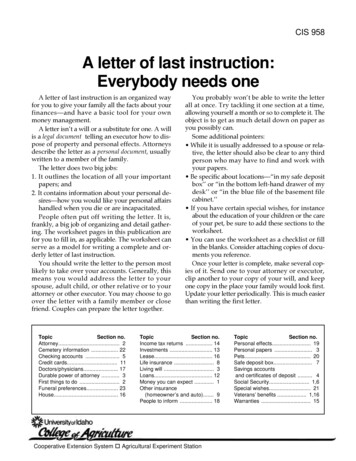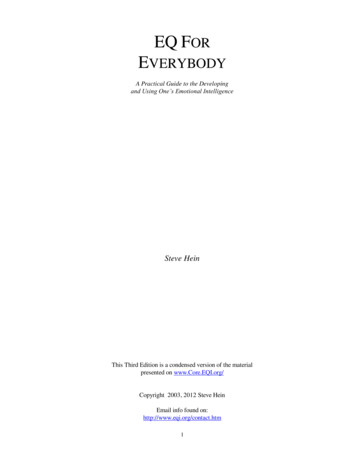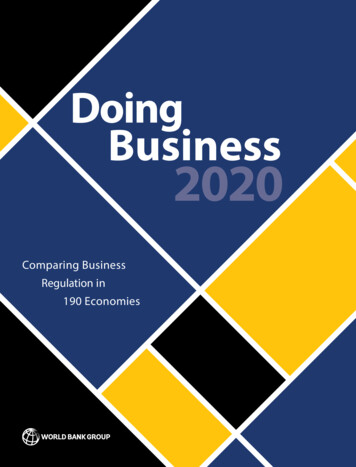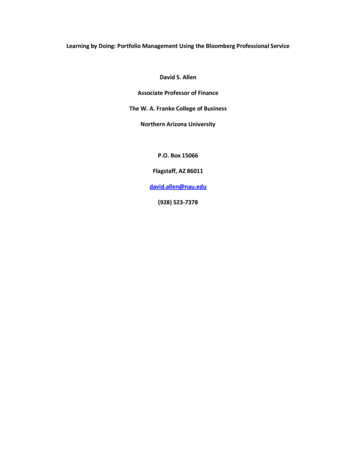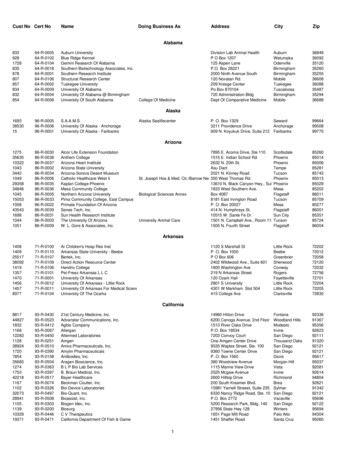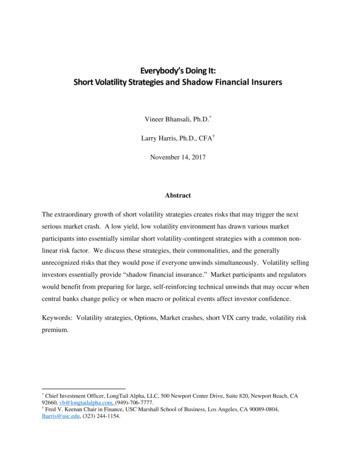
Transcription
Everybody’s Doing It:Short Volatility Strategies and Shadow Financial InsurersVineer Bhansali, Ph.D.*Larry Harris, Ph.D., CFA†November 14, 2017AbstractThe extraordinary growth of short volatility strategies creates risks that may trigger the nextserious market crash. A low yield, low volatility environment has drawn various marketparticipants into essentially similar short volatility-contingent strategies with a common nonlinear risk factor. We discuss these strategies, their commonalities, and the generallyunrecognized risks that they would pose if everyone unwinds simultaneously. Volatility sellinginvestors essentially provide “shadow financial insurance.” Market participants and regulatorswould benefit from preparing for large, self-reinforcing technical unwinds that may occur whencentral banks change policy or when macro or political events affect investor confidence.Keywords: Volatility strategies, Options, Market crashes, short VIX carry trade, volatility riskpremium.*Chief Investment Officer, LongTail Alpha, LLC, 500 Newport Center Drive, Suite 820, Newport Beach, CA92660, vb@longtailalpha.com, (949)-706-7777.†Fred V. Keenan Chair in Finance, USC Marshall School of Business, Los Angeles, CA 90089-0804,lharris@usc.edu, (323) 244-1154.
Traders who sell volatility essentially sell financial insurance. They allow other traders to profitwhen extreme events occur. The other traders often buy volatility to hedge portfolio risks. Thesimplest examples of volatility selling involve the sale of put and call contracts. Traders also cansell volatility when they trade products defined on volatility indices such as the VIX. Finally,many traders create short volatility positions when they engage in complex volatility-contingenttrading strategies such as risk parity and risk premium harvesting.Volatility as an asset class was once the exclusive domain of sophisticated hedge fund managersand Wall Street dealers. With the creation of various exchange traded volatility products, almostanyone now can easily trade volatility, and many do. These products allow even retail investorsto act as financial insurers as they seek to earn the well-documented volatility risk premium intheir stock trading accounts.Understanding volatility-contingent investing strategies is important to every investor. Whileinstitutional investors are certainly familiar with volatility, they might be surprised at how farvolatility trading and option selling has come in the last few years. Many non-institutionalinvestors such as retirees now unknowingly earn a substantial portion of their portfolio returnsfrom income their investment managers generate when they sell options or engage in strategieswith option characteristics. A severe market environment could expose everyone to rapid anddestructive bouts of unwinding.Herd-like behavior of investment managers can amplify the risks of short volatility-contingentstrategies. Past successes invite imitators and can result in excesses. The excesses createinstabilities that eventually can cause a cascade of risk reduction when the imitative behaviorplays in reverse.To perceptive observers, signs of crowding in the volatility space abound. Most importantly,many investors have no idea that they have entered essentially similar trading strategies.Accordingly, they do not recognize that liquidity may not be available to them when they want toadjust their positions in response to changing market conditions.Unfortunately, a defining characteristic of most short volatility-contingent strategies is that theirhedging and unwinding trades are destabilizing. When traders hedge and unwind in response to1
changing market conditions, their trades tend to accelerate those changes, which results in moreunwinding trades. This positive feedback may prove to be dangerous.One short volatility strategy—selling VIX through exchange-traded products—is stabilizing overshort time horizons. However, the assets deployed in this strategy are small in comparison tothose deployed in the other short volatility-contingent strategies. We believe that growth in thissmall strategy, and the media coverage of its recent success, may be partly responsible for thelow realized volatility in the markets over the last few years. However, the low realizedvolatility has emboldened traders in the other volatility-contingent strategies so that the danger ofshifting from a relatively stable local equilibrium to a very different equilibrium is high.In this paper, we provide an overview of short volatility-contingent strategies. We first identifythe strategies and who uses them. We then discuss the commonalities among the strategies andthe consequences of these commonalities. The short volatility ecosystem shows the classicproperty of a complex system: “the possible occurrence of coherent large-scale collectivebehaviors with a very rich structure, resulting from the repeated non-linear interactions among itsconstituents: the whole turns out to be much more than the sum of its parts” (see Sornette 2002).1 Who Trades Volatility-Contingent Strategies?Investors using volatility-contingent strategies lie along a hierarchical continuum based on theirinvestment time horizons. Ordered by their typical investment horizons, they are:Long horizon investors Very long-term investors Endowments and pension fundsMedium horizon investors Large asset managers Risk-parity hedge funds Risk premium harvesters Target volatility funds and variable annuitiesShort horizon investors Trend followers Volatility ETF and ETN investors2
Market makersThis classification is somewhat arbitrary as some investors engage in multiple strategies. Theorganization of our hierarchy is not important to the main purpose of this paper. It simply helpsillustrate that short volatility exposure is pervasive across all investor horizons.1.1 Long Horizon Investors1.1.1Very Long-Term InvestorsThe longest horizon volatility investors are mostly institutional investors such as sovereignwealth funds and large public pensions with very long investment horizons. These investors sellinsurance rather than buy it. They supply volatility in the market in exchange for which theyearn a premium.Much of the volatility selling of these long horizon investors is through their purchases of assetswith embedded option-like characteristics. Asset-backed credit securities are examples of suchsecurities as they generally have substantial prepayment and default options. Long horizoninvestors also take short volatility positions when they buy levered companies since thesecompanies become more volatile when values fall. Finally, their investments in private equityfunds investments also expose them to volatility because capital calls tend to arrive when theyare least welcome. The liquidity premia in these investments provide them long term alpha, butin periods of stress these strategies become correlated with other short volatility strategies.For these investors, any finite, non-zero option premium makes their investments—which theywould likely undertake anyway—more attractive. Accordingly, these investors often are notsensitive to the implied prices of the options in their portfolios. Their long investment horizonsmake them steady hands in the market. They are unlikely to turn into buyers of options except tocover their existing short option positions under market stress, regulatory change, or capital calls.1.1.2Endowments and Pension FundsPopulating the next shorter time horizon are very large pensions and endowments withsophisticated investment staffs who understand the options markets. Given the gigantic size ofmany of these capital pools, small sold options positions generally will not impair their portfoliosin times of large market shocks. By repeatedly selling options over time, they try to enhancetheir investment yields. In times of market stress, these investors are unlikely to buy options, but3
they may cut or significantly reduce their option selling programs. In terms of market impact,the practical difference between buying options or refusing to sell options is small. Thewithdrawal of these participants can substantially increase volatility. We discuss someconditions under which they might withdraw below.1.2 Medium Horizon Investors1.2.1Large Asset ManagersNext in the hierarchy are large asset managers with investment time horizons of three to fiveyears. Investors typically examine track records over such intervals when deciding whether togive managers assets (or more assets) to manage, which largely determines their fees. Thesemanagers generally attract funds by delivering alpha (performance in excess of risk-adjustedreturns). To augment their returns, and thereby attract more funds, many of these managers sellvolatility.Since non-linear option selling strategies are generally market neutral, in the short run, suchstrategies look like they do not have any market beta, at least to linear risk models such as theCAPM. For example, assume that a manager sells both puts and calls simultaneously in the formof a straddle or a strangle with strike prices centered on the current underlying asset value.These combinations have essentially zero delta at inception and thus zero contribution to marketbeta so that they do not add to the beta budget. Unless a risk monitor considers nonlinear risks,the income earned from selling such options can look like alpha, which provides the manager aperformance advantage over competitors who do not sell volatility, as long as the market doesnot move too much.Fund managers who sell volatility to augment their returns create a Peso Problem for theirinvestors. They obtain a small, regular augmented return at the cost of rare very large potentiallosses.1.2.2Risk-Parity FundsOther medium-term volatility participants include investment managers and hedge funds whofollow the risk-parity strategy. This strategy equalizes risk contribution across portfolio assetsby levering up low volatility assets. These managers do not explicitly sell volatility. Instead,4
their portfolio composition decisions—which depend on estimates of volatility—are sensitive tochanges in volatility and implicitly make them behave as though they are short volatility.A typical risk-parity fund operates as follows:1 Assume that a fund that invests in equities andbonds has an overall target volatility level of 14%, and that volatilities for equities and bondsrespectively are 20% and 5%. To obtain risk parity, the portfolio can lever up its bond portfolioby four times so that its bond portfolio has the same volatility as its equity portfolio. If thecorrelation between bonds and equities is zero, portfolio weights of approximately 0.5 and 2.0will produce the 14% target portfolio volatility with equal risk exposures to bonds and equities.When the correlation between equities and bonds is negative, as is usually assumed, the total riskof the portfolio benefits from diversification and the manager can take larger weights in bothassets classes. If equity volatility then falls, the manager must allocate more to equities tomaintain the same portfolio volatility target, and conversely if equity volatility rises.Since falling volatility has historically accompanied rising equity markets, risk-parity strategiesrespond to rising markets as if they are short volatility, i.e. they buy more equities as equityvolatility falls to target the same overall portfolio volatility. The systemic danger, of course, liesin the converse. When markets fall, volatilities rise, and these funds sell equities whichexacerbates the fall. Although risk-parity funds do not try to replicate options as do the fundsimplementing the portfolio insurance strategy, their response to market movements is the same.1.2.3Risk-Premium HarvestersRisk-premium harvesting funds appear next in the continuum. Financial theory going back towork by Ross in the 1960s shows that risk averse investors pay more risk-tolerant investors apremium for risk transfer. Risk-premium strategies grew rapidly with the democratization oftrading technology and the widespread availability of risk-factor models. Many participants nowimplement this strategy in a form popularized by Ilmanen (2011).Risk-premium harvesting funds systematically sell options contracts or engage in tradingstrategies such as currency carry trades that the implicitly offer options to the market. Theyattempt to earn the term premium from the fixed income yield curve, the dividend premium in1For a more complete description, see Bhansali etc. al. (2012).5
equities, the carry premium in currencies, and even the contango or backwardation premium incommodities. These strategies all involve the transfer of risk from a hedger to a speculator.Their expected returns are compensation for bearing volatility.21.2.4Volatility TargetingVolatility targeting is a close cousin of risk parity. Volatility targeting arose when the FinancialCrisis exposed the equity market tail risk of many variable annuity providers. Regulators thenrequired these providers to demonstrate that another such event would not create the samemagnitude of financial distress. Providers can satisfy this obligation by purchasing long-datedequity put options or by engaging in dynamic trading strategies that effectively produceprotective put options.Since purchasing puts is very expensive, most annuity providers use dynamic trading strategies.To target a given level or range of overall portfolio volatility, the simplest strategy systematicallysells equity index futures (say S&P 500 Index futures) if volatility rises, and buys the futures ifvolatility falls. Since the response function is driven by changes in volatility (usually withreference to VIX), this strategy also is implicitly short volatility. For instance, when volatilityrises, volatility targeters will sell futures to lower portfolio volatility to its target on theassumption that increased volatility will accompany ma
Short Volatility Strategies a nd Shadow Financial Insur ers Vineer Bhansali, Ph.D.* Larry Harris, Ph.D . many traders create short volatility positions when they engage in complex volatility-contingent trading strategies such as risk parity and risk premium harvesting. Volatility as an asset class was once the exclusive domain of sophisticated hedge fund managers and Wall Street dealers .

